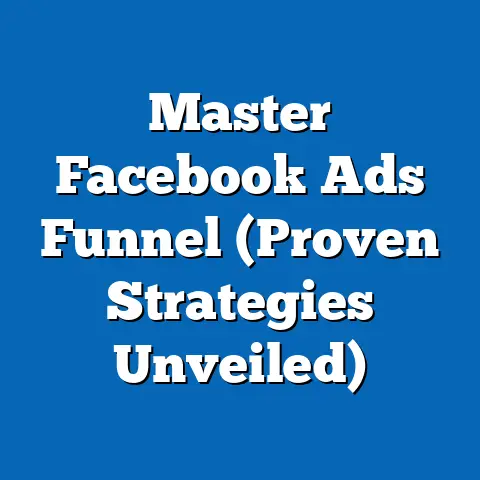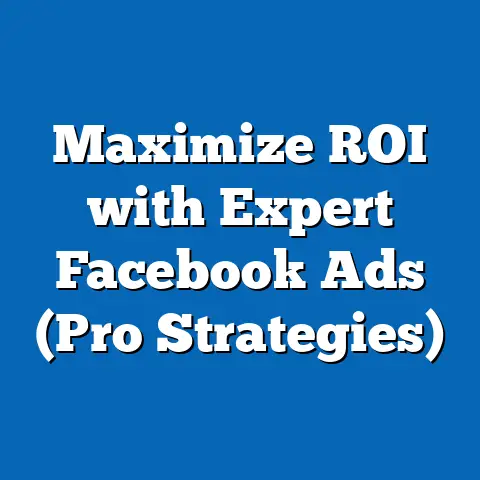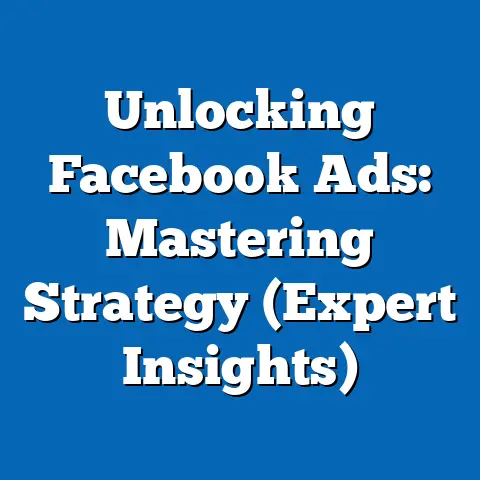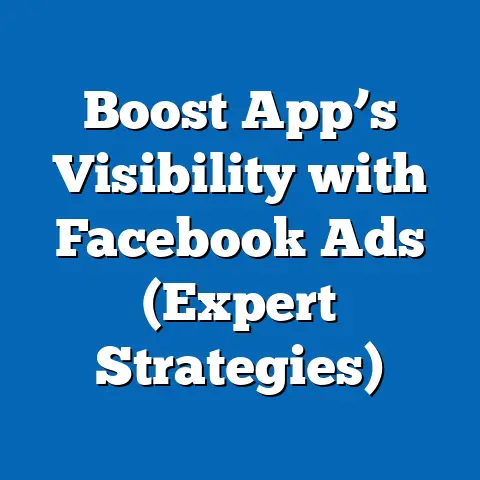Boost Engagement with Facebook Interactive Ads (Pro Tips)
Did you know that interactive ads can increase user engagement by up to 300% compared to traditional static ads? That’s not just a number; it’s a revolution in how we connect with audiences! As someone who’s spent years navigating the ever-changing landscape of Facebook advertising, I’ve seen firsthand how interactive ads can transform a campaign from a passive message into a dynamic conversation. In this guide, I’ll share my insights and pro tips to help you leverage the power of interactive ads and elevate your marketing game on Facebook.
Understanding Facebook Interactive Ads
Interactive ads are a game-changer in the world of Facebook advertising. Unlike traditional ads that passively display a message, interactive ads actively engage users, inviting them to participate, explore, and connect with your brand on a deeper level. Think of them as invitations to a party rather than just flyers posted on a wall.
So, what exactly are they? Interactive ads come in various forms, each designed to pique interest and encourage action. Some of the most popular types include:
- Poll Ads: These ads present users with a question and multiple-choice answers, allowing them to vote and see the results in real-time.
- Quiz Ads: Quiz ads challenge users’ knowledge or preferences with a series of questions, offering personalized results or recommendations based on their answers.
- Augmented Reality (AR) Ads: AR ads use smartphone cameras to overlay digital elements onto the real world, allowing users to virtually “try on” products or experience your brand in an immersive way.
- Carousel Ads: Carousel ads display multiple images or videos in a scrolling format, allowing users to explore different products, features, or aspects of your brand story.
- Playable Ads: Playable ads offer a mini-game experience, allowing users to interact with a simplified version of your app or game before downloading it.
- Instant Experience Ads (formerly Canvas Ads): These ads load a full-screen, mobile-optimized experience within Facebook, allowing you to showcase your brand with a combination of images, videos, text, and interactive elements.
The beauty of interactive ads lies in their ability to capture attention and hold it. Studies show that interactive content can generate significantly higher engagement rates than static content, leading to increased brand awareness, lead generation, and sales. I’ve personally seen campaigns where engagement rates jumped from a measly 1% on static ads to over 10% with a well-executed interactive campaign.
Takeaway: Interactive ads are dynamic, engaging, and offer a powerful way to connect with your audience on Facebook. By understanding the different types of interactive ads and their unique capabilities, you can start brainstorming creative ways to incorporate them into your marketing strategy.
The Importance of Engagement in Advertising
In today’s digital landscape, engagement is the lifeblood of successful advertising. It’s no longer enough to simply broadcast your message; you need to create meaningful connections with your audience, spark conversations, and build lasting relationships.
Think of it this way: traditional advertising is like shouting into a crowd, hoping someone will hear you. Interactive advertising, on the other hand, is like striking up a conversation with someone, listening to their needs, and offering a solution that resonates with them.
Why is engagement so crucial?
- Increased Brand Awareness: When users actively engage with your ads, they’re more likely to remember your brand and associate it with positive experiences.
- Higher Conversion Rates: Engaged users are more likely to take action, whether it’s visiting your website, signing up for your email list, or making a purchase.
- Improved Customer Retention: By creating interactive experiences that provide value and entertainment, you can foster customer loyalty and encourage repeat business.
- Valuable Feedback: Interactive ads can provide valuable insights into your audience’s preferences, opinions, and needs, allowing you to refine your messaging and product offerings.
I remember running a campaign for a local coffee shop that was struggling to attract new customers. We decided to try a poll ad asking users what their favorite coffee drink was. The results not only gave us valuable insights into their preferences but also sparked a lively conversation in the comments section. The coffee shop saw a significant increase in foot traffic and sales in the following weeks, all thanks to a simple poll ad.
Takeaway: Engagement is the key to unlocking the full potential of your Facebook advertising campaigns. By creating interactive experiences that capture attention, spark conversations, and provide value, you can build stronger relationships with your audience and drive meaningful results for your business.
Pro Tips for Creating Effective Facebook Interactive Ads
Now that we’ve established the importance of interactive ads and their potential benefits, let’s dive into some pro tips for creating effective campaigns that drive engagement and deliver results.
Tip 1: Know Your Audience
This might sound obvious, but it’s the foundation of any successful marketing campaign. Before you start creating interactive ads, take the time to understand your target audience’s preferences, behaviors, and interests.
What are their demographics? What are their pain points? What kind of content do they enjoy engaging with?
Facebook’s Audience Insights tool can be a goldmine of information, providing valuable data on your audience’s demographics, interests, behaviors, and page likes. You can also use your existing customer data, such as email lists and website analytics, to gain a deeper understanding of your audience.
For example, if you’re targeting millennials, you might want to use a quiz ad that tests their knowledge of pop culture or a carousel ad that showcases the latest fashion trends. If you’re targeting busy parents, you might want to use a poll ad that asks them about their favorite time-saving hacks or an AR ad that allows them to virtually try on new baby products.
I once worked with a clothing brand that was struggling to connect with its target audience of Gen Z consumers. After analyzing their social media data, we discovered that they were highly interested in sustainable fashion and social activism. We created a quiz ad that asked users about their ethical fashion choices and provided personalized recommendations for sustainable clothing brands. The ad generated a huge amount of engagement and helped the brand establish itself as a leader in the sustainable fashion movement.
Takeaway: Understanding your audience is the key to creating interactive ads that resonate with them and drive engagement. Use Facebook’s Audience Insights tool and your existing customer data to gain a deeper understanding of their preferences, behaviors, and interests.
Tip 2: Leverage Compelling Visuals
Visuals are the first thing people see when they encounter your ad, so it’s crucial to make a strong impression. Use eye-catching images, videos, and graphics that capture attention and entice users to interact with your ad.
Here are some tips for creating compelling visuals:
- Use high-quality images and videos: Avoid using blurry or pixelated images.
- Choose visuals that are relevant to your brand and message: Make sure your visuals align with your brand identity and the content of your ad.
- Use bright colors and bold designs: Capture attention and stand out from the crowd.
- Use visuals that evoke emotion: Connect with your audience on an emotional level.
- Consider using animated GIFs or short video clips: Add a touch of fun and interactivity.
I’ve found that using visuals that feature real people, especially those who resemble your target audience, can be particularly effective. People are more likely to connect with ads that feel authentic and relatable.
For example, a food delivery service could use a carousel ad that showcases mouth-watering photos of their most popular dishes. A travel agency could use a video ad that features stunning footage of exotic destinations. A fitness brand could use an AR ad that allows users to virtually try on their latest workout gear.
Takeaway: Compelling visuals are essential for capturing attention and driving engagement with your Facebook interactive ads. Use high-quality images, videos, and graphics that are relevant to your brand and message, and consider using visuals that evoke emotion or feature real people.
Tip 3: Craft Engaging Questions and Challenges
The key to creating engaging interactive ads is to ask questions or pose challenges that are relevant, interesting, and thought-provoking.
Here are some tips for crafting engaging questions and challenges:
- Keep it short and sweet: Avoid using long, complicated questions.
- Make it relatable: Ask questions that your audience can easily relate to.
- Offer multiple-choice answers: Make it easy for users to participate.
- Provide instant feedback: Let users know how they did and why.
- Offer incentives: Reward users for participating with discounts, coupons, or other exclusive offers.
Poll ads are a great way to gather quick feedback from your audience and spark conversations. Quiz ads can be used to test their knowledge or preferences and provide personalized recommendations. Challenge ads can be used to encourage users to participate in contests or giveaways.
For instance, a cosmetics brand could use a poll ad that asks users about their favorite makeup trends. A tech company could use a quiz ad that tests users’ knowledge of their latest products. A travel agency could use a challenge ad that encourages users to share their travel photos for a chance to win a free vacation.
I once ran a campaign for a local bookstore that was trying to promote its summer reading program. We created a quiz ad that asked users about their favorite book genres and provided personalized recommendations for summer reads. The ad generated a huge amount of engagement and helped the bookstore attract new customers to its reading program.
Takeaway: Engaging questions and challenges are the heart of interactive ads. Craft questions and challenges that are relevant, interesting, and thought-provoking, and offer incentives to encourage participation.
Tip 4: Utilize Facebook’s Ad Tools and Features
Facebook offers a variety of ad tools and features that can help you create interactive ads that are both engaging and effective.
Some of the most useful tools and features include:
- Facebook Ads Manager: This is your central hub for creating, managing, and tracking your Facebook ad campaigns.
- Facebook Pixel: This code snippet allows you to track user behavior on your website and optimize your ads for conversions.
- Custom Audiences: This feature allows you to target your ads to specific groups of people based on their demographics, interests, behaviors, and website activity.
- Lookalike Audiences: This feature allows you to target your ads to people who are similar to your existing customers.
- Facebook Canvas (now Instant Experience): This feature allows you to create full-screen, mobile-optimized experiences within Facebook.
To create an interactive ad using Facebook’s ad tools, follow these steps:
- Go to Facebook Ads Manager and create a new campaign.
- Choose your campaign objective (e.g., engagement, website traffic, conversions).
- Define your target audience using Custom Audiences or Lookalike Audiences.
- Choose your ad placement (e.g., Facebook feed, Instagram feed, Audience Network).
- Select your ad format (e.g., poll ad, quiz ad, carousel ad).
- Create your ad copy and visuals.
- Add interactive elements, such as questions, challenges, or AR filters.
- Set your budget and schedule.
- Review and publish your ad.
Don’t be afraid to experiment with different ad formats, targeting options, and interactive elements to see what works best for your audience.
Takeaway: Facebook offers a powerful suite of ad tools and features that can help you create interactive ads that are both engaging and effective. Take the time to learn how to use these tools and features to their full potential.
Tip 5: Test and Optimize Your Ads
No matter how well you plan your interactive ad campaigns, it’s essential to test and optimize them to ensure they’re delivering the best possible results.
A/B testing is a great way to compare different ad formats, targeting options, and interactive elements to see which ones perform best. You can also use Facebook’s ad analytics to track your ad performance and identify areas for improvement.
Here are some metrics to track:
- Reach: The number of people who saw your ad.
- Impressions: The number of times your ad was displayed.
- Engagement: The number of likes, comments, shares, and clicks your ad received.
- Click-Through Rate (CTR): The percentage of people who clicked on your ad after seeing it.
- Conversion Rate: The percentage of people who took the desired action after clicking on your ad (e.g., visiting your website, signing up for your email list, making a purchase).
- Cost Per Click (CPC): The amount you paid for each click on your ad.
- Cost Per Conversion (CPC): The amount you paid for each conversion.
By analyzing these metrics, you can identify which ads are performing well and which ones need improvement. You can then make adjustments to your ad copy, visuals, targeting options, or interactive elements to optimize your campaigns for better results.
I always recommend starting with small-scale A/B tests to validate your assumptions before investing heavily in a particular ad format or strategy.
Takeaway: Testing and optimization are essential for maximizing the ROI of your Facebook interactive ad campaigns. Use A/B testing to compare different ad formats and interactive elements, and track your ad performance using Facebook’s ad analytics.
Case Studies and Success Stories
Let’s take a look at some real-world examples of brands that have successfully implemented interactive ads on Facebook.
Case Study 1: Sephora’s AR Makeup Try-On
Sephora, the beauty retailer, has been a pioneer in using AR ads to allow users to virtually try on makeup products before making a purchase. By using Facebook’s AR platform, Sephora has created an immersive and engaging experience that allows users to see how different makeup products look on their own faces. This has led to increased engagement, higher conversion rates, and a more personalized shopping experience.
Key Takeaways:
- AR ads can provide a unique and engaging experience that sets your brand apart from the competition.
- By allowing users to virtually try on products, you can increase their confidence and encourage them to make a purchase.
- AR ads can be used to personalize the shopping experience and provide tailored recommendations.
Case Study 2: Domino’s Pizza’s Poll Ads
Domino’s Pizza has used poll ads to engage its audience and gather feedback on its menu offerings. By asking users about their favorite pizza toppings or crust types, Domino’s has been able to gain valuable insights into their preferences and tailor its menu accordingly. This has led to increased customer satisfaction and higher sales.
Key Takeaways:
- Poll ads are a great way to gather quick feedback from your audience and spark conversations.
- By asking users about their preferences, you can gain valuable insights into their needs and tailor your offerings accordingly.
- Poll ads can be used to promote new products or services and generate buzz around your brand.
Case Study 3: Netflix’s Interactive Video Ads
Netflix has been experimenting with interactive video ads that allow users to choose their own adventure. By presenting viewers with multiple options at key moments in the video, Netflix has created an immersive and engaging experience that keeps them hooked from start to finish. This has led to increased brand awareness, higher engagement rates, and a more personalized viewing experience.
Key Takeaways:
- Interactive video ads can provide a unique and engaging experience that keeps viewers hooked from start to finish.
- By allowing users to choose their own adventure, you can create a more personalized viewing experience.
- Interactive video ads can be used to promote your brand, showcase your products or services, and drive conversions.
Takeaway: These case studies demonstrate the power of interactive ads to drive engagement, increase brand awareness, and boost sales. By learning from these success stories, you can start brainstorming creative ways to incorporate interactive ads into your own marketing strategy.
Future Trends in Interactive Advertising
The world of interactive advertising is constantly evolving, with new technologies and trends emerging all the time. Here are some of the future trends to watch out for:
- Artificial Intelligence (AI): AI is already being used to personalize ads, target audiences, and optimize campaigns. In the future, AI will play an even bigger role in interactive advertising, enabling brands to create more engaging and personalized experiences.
- Personalization: Consumers are increasingly demanding personalized experiences that are tailored to their individual needs and preferences. Interactive ads offer a great way to deliver personalized content and recommendations.
- Immersive Experiences: Technologies like virtual reality (VR) and augmented reality (AR) are creating new opportunities for brands to create immersive and engaging experiences that transport users to another world.
- Voice Search: With the rise of voice assistants like Siri and Alexa, voice search is becoming increasingly popular. Brands will need to optimize their interactive ads for voice search to reach consumers who are using these devices.
- Social Commerce: Social commerce is the practice of selling products or services directly through social media platforms. Interactive ads can be used to drive social commerce by allowing users to purchase products or services directly from the ad.
To stay ahead of the curve, brands need to embrace these emerging trends and experiment with new technologies and strategies.
I believe that the future of advertising is interactive, personalized, and immersive. By embracing these trends, brands can create more engaging and effective campaigns that drive results.
Takeaway: The future of interactive advertising is bright, with new technologies and trends emerging all the time. Stay ahead of the curve by embracing these trends and experimenting with new strategies.
Conclusion
Interactive ads are a powerful tool for driving engagement, increasing brand awareness, and boosting sales on Facebook. By understanding the different types of interactive ads, following the pro tips outlined in this guide, and staying ahead of emerging trends, you can create campaigns that capture attention, spark conversations, and deliver meaningful results for your business.
Don’t be afraid to experiment with different ad formats, targeting options, and interactive elements to see what works best for your audience. And remember, the key to success is to create experiences that are relevant, engaging, and valuable to your target audience.
Now it’s your turn to take these tips and run with them. Start experimenting, start engaging, and start seeing the amazing results that interactive Facebook ads can bring. Your audience is waiting to be engaged – go give them something to talk about!






